How To Count 32nd Notes Out Loud
eighteen More Notes, 30-Second Rhythms & Swing
INTRODUCTION
In this unit you will learn more than fretted notes on the first cord, thirty-second note rhythms and unlike methods for notating swing rhythm.
NOTATIONS
Notes
The Note 'E'
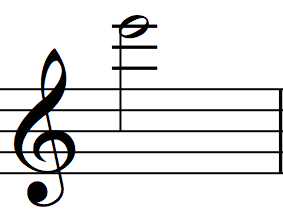
'East' is in the tertiary leger line higher up the staff. To play 'E,' fret the twelfth fret on the starting time string.
The Note 'F'
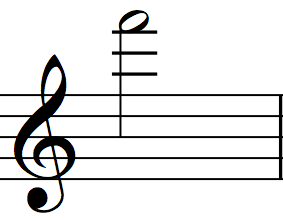
'F' sits on top of the third leger line above the staff. To play 'F' fret the thirteenth fret on the first string.
The Notes 'F♯' or '1000♭'
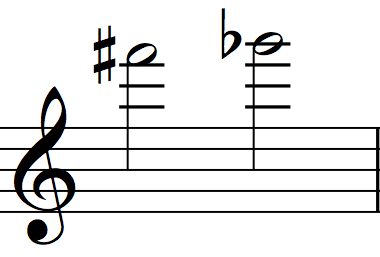
'F♯' and 'G♭' are enharmonics. To play 'F♯' or 'One thousand♭', fret the fourteenth fret on the first string.
The Annotation 'G'
'K' sits on top of the fourth leger line above the staff. To play 'One thousand' fret the fifteenth fret on the first string.
Rhythms
30-Second Note in Simple Meter
A thirty-2nd note sustains for one-eighth of a trounce in simple meter. The 30-second notation tin can be written in two means: either with three beams or three flags.
Beamed Xxx-Second Notes
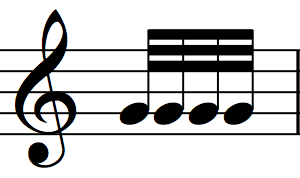
This example contains four thirty-2nd notes.. The thirty-2nd annotation consists of a annotation head that is colored in, a stem and iii beams.
Flagged Thirty-Second Notes
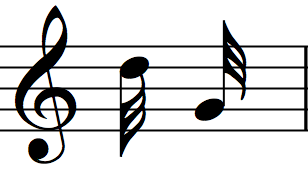
In this case, the thirty-second notes contain flags instead of beams.
Thirty-2d Balance
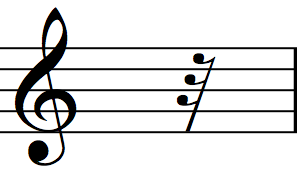
A thirty-2d residuum creates silence for one-eighth of a shell in elementary meter. It consists of a diagonal line with iii small flags.
How to Count Xxx-Second Notes in Simple Meter
It'south impossible to count xxx-second notes in a methodical manner at a brisk tempo, only because they proceed faster than most of united states of america can count. Therefore, it is best to devote part of your exercise to recognizing and playing different combinations of thirty-second and sixteenth notes. Aim to play them in relation to the pulse in an intuitive (not intellectual) manner. However, while developing this skill, it will assistance to slow down the pulse and count according to the method below. When this becomes manageable, speed upwardly the pulse (little past little) until you count only the pulse, not the rhythmic sub-divisions of the pulse.

I recommend counting in the manner described above (view the video for a sit-in). The beginning eighth of the shell receives a number, which represents the its placement in the measure. The second eighth of the vanquish receives the sound 'di.' The tertiary eighth of the shell receives the sound 'ee.' The 4th eighth of the beat receives the sound 'da.' The 5th 8th of the vanquish receives the sound '&.' The 6th eighth of the shell receives the audio 'di.' The seventh eighth of the beat out receives the audio 'ah.' The concluding eighth of the crush receives the sound 'da.'
Bear in heed that thirty-second notes are usually ornamental. When applicative, it volition help to recognize them as a trill, turn, mordent, etc. Farther, ornaments are often played with a greater degree of expression and flexibility considering they are non every bit structurally important as melody. Despite this fact, many composers asking that musicians perform thirty-2d notes and ornaments with rhythmic precision.
Dotted Sixteenth Note & Rest in Simple Meter
The dotted sixteenth note sustains for three-quarters of a half of a beat in simple meter.
Dotted Sixteenth Annotation
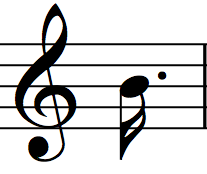
The dotted sixteenth note consists of a sixteenth note with a dot positioned shut to the notehead.
Dotted Sixteenth Residual
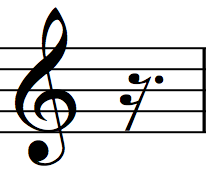
The dotted sixteenth rest creates silence for 3-quarters of a one-half of a crush. The dotted sixteenth balance consists of a sixteenth rest with a dot positioned close to the symbol.
Dotted Sixteenth & Xxx-Second Notation Combinations in Simple Meter

The dotted sixteenth and thirty-2d annotation frequently beam together to form recognizable groups. 2 combinations are above. View the video for a sit-in.
Sixteenth & 30-Second Note Combinations in Uncomplicated Meter

Sixteenth and thirty-2nd notes oft axle together to form recognizable groups. Three combinations are above. View the video for a demonstration.
Meters for Swing Rhythm
Many of you lot already know swing rhythm, as it is key to blues and jazz music. Swing rhythm involves a consistent and asymmetrical subdivision of the vanquish that (in well-nigh cases) can't exist accurately represented using the rhythmic symbols bachelor standard notation. As a result, the note used to stand for swing is only an approximation of the rhythm itself. Nonetheless, musicians take attempted to notate swing rhythm in various ways for over a century. In nearly all cases, the word swing is written to a higher place the fourth dimension signature.
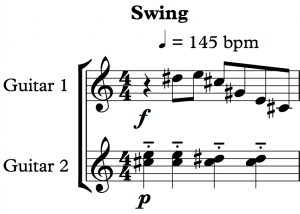
Virtually musicians advocate to notate swing rhythm in elementary meter, as in the example above from Swing by Emile Porée. In this piece each eighth-note group (as seen in Guitar 1) should not exist played straight—with equal subdivisions of the beat. Instead, each eighth-note group should be swung—with asymmetrical subdivisions of the beat. The crush subdivision in swing is often described as long-short or doo-bah. View the video for a sit-in.
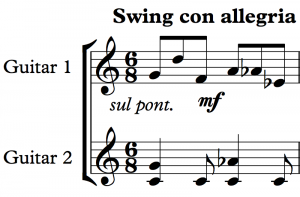
Shuffle rhythm is a type of swing rhythm that tin can be noted accurately. It occurs when the asymmetrical subdivision of the trounce adheres to a ii:1 ratio. This rhythm is typically notated in simple meter (similar other forms of swing) with the word shuffle (or swing) written above the time signature. However, in the example higher up from Crazy Vertical Blues by Joan Greenwald, shuffle rhythm (as seen in the Guitar two function) is notated in compound meter. View the video for a demonstration.
| | Allow'southward Play |
Sight-Reading Tip
If you are interested in developing swing rhythm, bear in mind that there are many ways to swing! Further, the swingfeel is achieved past a combination of articulation, phrasing and rhythm. Therefore, I propose yous listen to dandy blues and jazz musicians, emulate their swing and eventually play in a style that feels correct for y'all.
Checklist for Sight-Reading
- Count the beats out loud (including the&).
- Keep going (even if you make a mistake).
- Maintain your best playing posture.
- Look at the score, not your hands.
- Play with the feel of the meter.
- Play patterns instead of private notes (AKA chunk).
- Cultivate a calm demeanor.
- Take fun!
| | Let's Play Rhythms |
Attitude Tip
The measure of who nosotros are is what we do with what nosotros have. –Vince Lombardi
Exercise 18.ane: Score
Exercise eighteen.1: Audio
Practice 18.two: Score
Exercise 18.2: Sound
Exercise 18.3: Score
Exercise 18.3: Audio
| | Let'southward Play Patterns |
Mental attitude Tip
Perfection is not attainable, but if nosotros chase perfection we can catch excellence. –Vince Lombardi
Exercise 18.iv: Score
Exercise xviii.4: Audio
Exercise 18.5: Score
Exercise xviii.five: Audio
Exercise eighteen.half-dozen: Score
Exercise 18.v: Sound
| | Let's Play Duets |
Attitude Tip
The greatest accomplishment is not in never falling, only in rising again afterwards you lot fall. –Vince Lombardi
Pavana I by Luis de Milán: Score
Pavana I: Audio
| | Allow'southward Play Compositions |
These compositions are nether the Artistic CommonsAttribution-NonCommercial iv.0 International License (CC BY-NC 4.0).
Attitude Tip
We would accomplish many more than things if we did not call up of them as impossible. –Vince Lombardi
Swing by Emile Porée: Score
Swing: Sound
Crazy Vertical Dejection by Joan Greenwald: Score
Crazy Vertical Blues: Sound
Obelisk No. four by Ashraf Fouad: Score
Obelisk No. 4: Audio
The next slice contains a refrain. The refrain starts at the Segno (on the first page, third system) and ends at the Coda (on the first page, fourth system). Detect that the piece is divided into four major sections, labeled A, B, C and D. When y'all meet the Segno/Coda symbols in Sections B, C, and D jump dorsum to the beginning of the refrain in Section A. At the stop of the refrain, when yous encounter the Coda, bound dorsum to the Coda in either the B, C, or D sections.
Guitar Samaie by Ashraf Fouad: Score
Guitar Samaie: Audio
Congratulations!
You have completed this unit of measurement! If you kept up with the beat and accurately played approximately 70% of the pitches and rhythms, you are prepare for the next unit. Experience free to repeat the exercises. However, do not play them so oftentimes that you memorize them. Once yous memorize the notation, you are no longer developing the skill of sight-reading.
Source: https://press.rebus.community/sightreadingforguitar/chapter/more-notes-on-the-first-string-atonality-cut-time-swing-rhythm/


0 Response to "How To Count 32nd Notes Out Loud"
Post a Comment